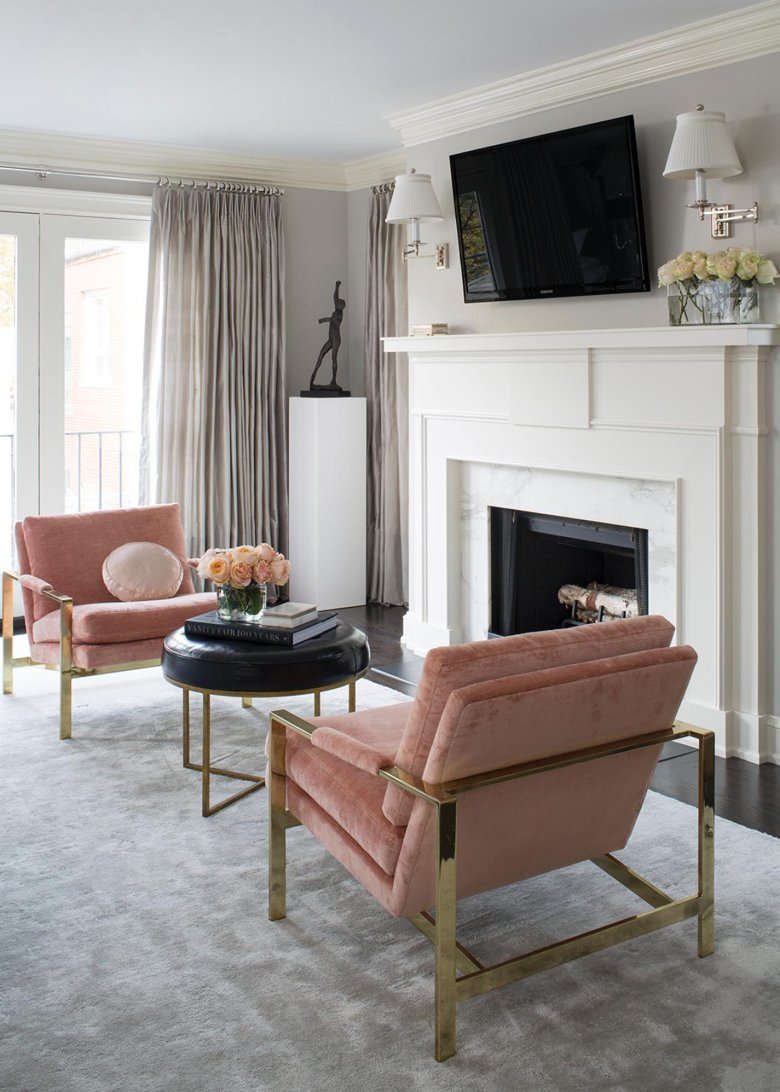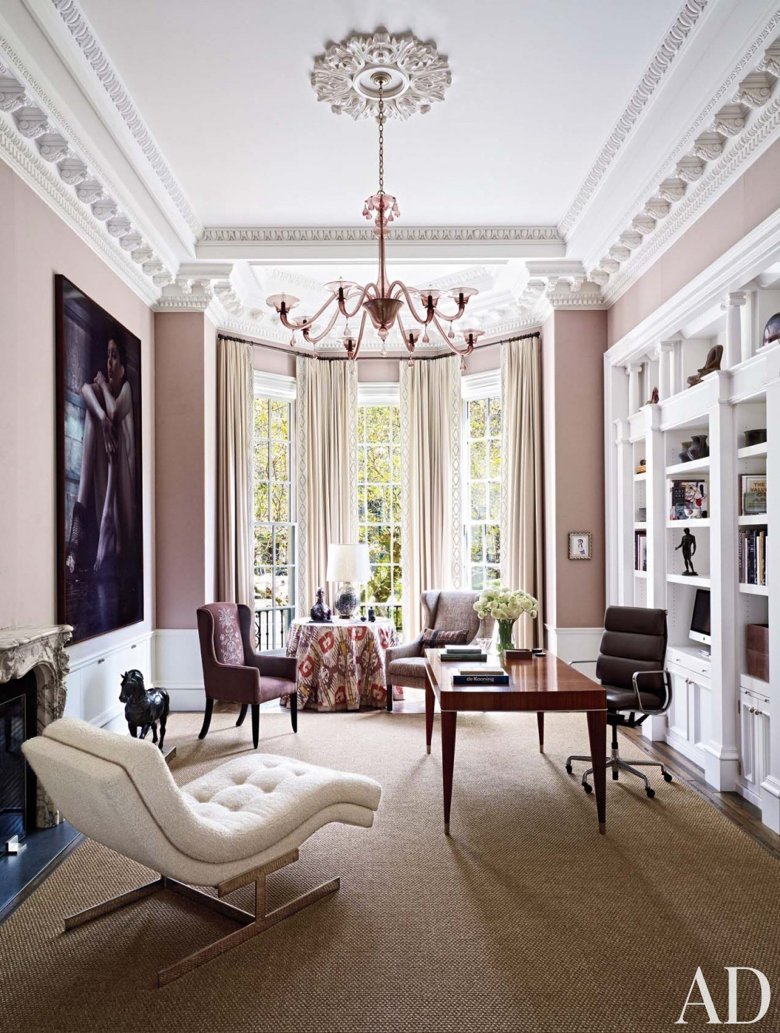DESIGN DICTIONARY: Milo Baughman
In the master bedroom’s sitting area, vintage chairs designed by Milo Baughman are upholstered with a Pierre Frey linen-velvet from Holly Hunt and flank an Oly ottoman. A custom silver silk carpet by Labrum, fabricated by Direct Rug Import, plays off silver silk draperies from Fabricut.
Milo Baughman is one of the most enduring designers of the midcentury modern period. His work is still produced by Thayer-Coggin and is available at retail giants like Crate & Barrel and Design Within Reach. The market for his vintage pieces is robust.
He is certainly a designer to know. Let's start with the pronunciation of Baughman's name. It's BAWF-man.
Thomas Ruff’s photograph Substrat 24 I dominates the living room of Jamie Drake’s Manhattan apartment. Arranged around a marble-and-granite table by Drake Design Assoc. are a Milo Baughman lounge chair in a Christopher Hyland mohair, a Drake-designed sofa in a Schumacher fabric, and a pair of club chairs and a Bright Group ottoman that are covered in Rubelli velvets from Donghia. The curtains are of a Clarence House fabric, and the walls are painted in Benjamin Moore’s Sidewalk Gray, with a Venetian-plaster finish by the Alpha Workshops. The carpet is by the Alpha Workshops for Edward Fields.
Often considered one of the founders of the "California Modern," look, Milo Baughman designed functional furniture with a creative form. Admirers call it "sexy" and 'groovy." Look at the pictures in this post to get a grasp on his most iconic designs.
Fun fact: Baughman was a child prodigy! At age 13 (!), his parents entrusted him with the design of the exterior and interior of the family home they were building. Mom and Dad enjoyed living in the results for 34 years.
Let's take a look at his work.
Signature Furniture
While mod patterned upholstery often adorns vintage Baughman, he based his aesthetic on a creative use of materials like chrome, brass, glass, leather and beautiful burl wood. He built upon the legacy of Ludwig Mies van der Rohe and Marcel Breuer and valued functional furniture above all else, perhaps explaining the longevity of his designs.
Milo Baughman believed that furniture should look as good from the back as it does from the front. His trademark is the flat bar metal frames that encased lounge chairs and sofas. Baughman's swiveling chair, which often rests on a round brass base, also is iconic. In addition, many replicate his chrome and glass Greek Key etagere, so called for it's greek key feet. When it comes to upholstery, Baughman's plush sofas, especially his sectionals, are synonymous with the lounge life of the 1970s Hollywood Rat pack and are still prized today for their comfort. Finally, apart from metal and glass, Milo Baughman's credenzas, consoles and tables that feature burl wood are highly desired.
Furniture by Milo Baughman
Furniture by Milo Baughman
How To Recognize Vintage Milo Baughman
It's tough to tell. Many people copied Baughman's designs back in the day just as they do now. Knowing Baughman's professional history helps. First, remember that Milo Baughman designed for Thayer-Coggin for 50 years, so most of his iconic pieces were produced there. Begin your research by studying the Thayer-Coggin website to determine if your vintage find matches up with the design of pieces in current production. He began designing for Thayer-Coggin in 1953 and continued until his death in 2003.
A Martin Eder photograph presides over the study in a Boston townhouse; the 1930s Venini chandelier is from Doris Leslie Blau, the vintage chaise longue is a Milo Baughman design for Thayer Coggin, and the leather-bound sisal is by Stark.
Milo Baughman designed for a number of other furniture makers as well, including Mode Furniture, Glenn of California, The Inco Company, Pacific Iron, Murray Furniture of Winchendon, Arch Gordon, Design Institute America, George Kovacs, Directional, Henredon and Drexel. Specific information on Baughman's designs for those companies is hard to find. I like to eyeball the offerings on 1st dibs for clues. That's how I found my Milo Baughman for Directional credenza.
We do know that Baughman's early work for Glenn and Pacific Iron resulted in his "California Modern" reputation. That work is characterized by a wide use of walnut, leather and formica.
1955 coffee table by Milo Baughman for Glenn of California
Milo Baughman desk for Winchendon include in the 1985 exhibition by the Whitney Museum, "High Styles: Twentieth Century Furniture Design
Baughman next designed for Drexel and following Drexel, Winchedon. The Whitney Museum included this early 1948 desk for Winchendon in an exhibition entitled "High Styles: Twentieth Century Furniture Design" in 1985.
Of course, frequently published design luminaries from Nate Berkus to Martyn Lawrence Bullard have Milo Baughman in their homes, so combing your favorite shelter publications also will build your knowledge.
Milo Baughman chairs in Nate Berkus' home
Martyn Lawrence Bullard's home in Palm Springs. The master suite’s sitting room boasts a Karl Springer bookcase, a Willy Rizzo cocktail table, and a vintage Milo Baughman lounge chair covered in Loro Piana Interiors silk.
Are you attracted to Baughman's groovy vibe?
Milo Baughman and Thayer Coggin
Photo credits: Desk from Whitney exhibition from Sotheby's Photo with Directional credenza by Ellen Mcdermott. Photo with Pink chairs from Luxe Magazine. Glenn of California desk.













